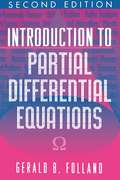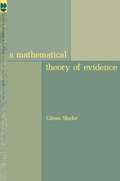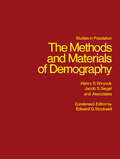- Table View
- List View
Introduction to Equilibrium Analysis: Variations on Themes by Edgeworth and Walras (ISSN #Volume 6)
by W. Hildenbrand A. P. KirmanAdvanced Textbooks in Economics, Volume 6: Introduction to Equilibrium Analysis: Variations on Themes by Edgeworth and Walras focuses on the approaches developed and instituted by Edgeworth and Walras in the study of equilibrium analysis. The book first underscores exchange economies, core of a game, and large economies. Discussions focus on economies with a continuum of agents, Walras equilibrium, prices and demand, balancedness, and commodity space. The manuscript then ponders on limit theorems for the core and existence of competitive equilibria. Topics include equilibria without convexity of preferences, existence of equilibria for economies with convex preferences, individual demand, emergence of prices, asymptotic equal treatment for most, uniform boundedness of core allocations, and limit theorems for type and replica economies. The publication examines continuous, upper, and lower hemi-continuous correspondences, fixed point theorems, and separation of convex sets. The book is a vital source of data for economists and researchers interested in equilibrium analysis.
Introduction to Partial Differential Equations: Second Edition (Mathematical Notes #102)
by Gerald B. FollandThe second edition of Introduction to Partial Differential Equations, which originally appeared in the Princeton series Mathematical Notes, serves as a text for mathematics students at the intermediate graduate level. The goal is to acquaint readers with the fundamental classical results of partial differential equations and to guide them into some aspects of the modern theory to the point where they will be equipped to read advanced treatises and research papers. This book includes many more exercises than the first edition, offers a new chapter on pseudodifferential operators, and contains additional material throughout. The first five chapters of the book deal with classical theory: first-order equations, local existence theorems, and an extensive discussion of the fundamental differential equations of mathematical physics. The techniques of modern analysis, such as distributions and Hilbert spaces, are used wherever appropriate to illuminate these long-studied topics. The last three chapters introduce the modern theory: Sobolev spaces, elliptic boundary value problems, and pseudodifferential operators.
Investigations in Modal and Tense Logics with Applications to Problems in Philosophy and Linguistics (Synthese Library #92)
by Dov M. GabbayThis book is intended to serve as an advanced text and reference work on modal logic, a subject of growing importance which has applications to philosophy and linguistics. Although it is based mainly on research which I carried out during the years 1969-1973, it also includes some related results obtained by other workers in the field (see the refer ences in Part 7). Parts 0, 1 and 2, can be used as the basis of a one year graduate course in modal logic. The material which they contain has been taught in such courses at Stanford since 1970. The remaining parts of the book contain more than enough material for a second course in modal logic. The exercises supplement the text and are usually difficult. I wish to thank Stanford University and Bar-Han University for making it possible for me to continue and finish this work, and A. Ungar for correcting the typescript. Bar-Ilan University, Israel Dov M. GABBA Y PART 0 AN INTRODUCTION TO GENERAL INTENSIONAL LOGICS CHAPTER 0 CONSEQUENCE RELATIONS Motivation We introduce the notions of a consequence relation (which is a generalization of the notion of a logical system) and of a semantics. We show that every consequence relation is complete for a canonical semantics. We define the notion of one semantics being Dian in another and study the basic properties of this notion. The concepts of this chapter are generalizations of the various notions of logical system and possible world semantics found in the literature.
An Invitation to C*-Algebras (Graduate Texts in Mathematics #39)
by W. ArvesonThis book gives an introduction to C*-algebras and their representations on Hilbert spaces. We have tried to present only what we believe are the most basic ideas, as simply and concretely as we could. So whenever it is convenient (and it usually is), Hilbert spaces become separable and C*-algebras become GCR. This practice probably creates an impression that nothing of value is known about other C*-algebras. Of course that is not true. But insofar as representations are con cerned, we can point to the empirical fact that to this day no one has given a concrete parametric description of even the irreducible representations of any C*-algebra which is not GCR. Indeed, there is metamathematical evidence which strongly suggests that no one ever will (see the discussion at the end of Section 3. 4). Occasionally, when the idea behind the proof of a general theorem is exposed very clearly in a special case, we prove only the special case and relegate generalizations to the exercises. In effect, we have systematically eschewed the Bourbaki tradition. We have also tried to take into account the interests of a variety of readers. For example, the multiplicity theory for normal operators is contained in Sections 2. 1 and 2. 2. (it would be desirable but not necessary to include Section 1. 1 as well), whereas someone interested in Borel structures could read Chapter 3 separately. Chapter I could be used as a bare-bones introduction to C*-algebras. Sections 2.
Komplementaritäts- und Fixpunktalgorithmen in der mathematischen Programmierung, Spieltheorie und Ökonomie (Lecture Notes in Economics and Mathematical Systems #129)
by H.-J. LüthiLogic and Probability in Quantum Mechanics (Synthese Library #78)
by Patrick SuppesDuring the academic years 1972-1973 and 1973-1974, an intensive sem inar on the foundations of quantum mechanics met at Stanford on a regular basis. The extensive exploration of ideas in the seminar led to the org~ization of a double issue of Synthese concerned with the foundations of quantum mechanics, especially with the role of logic and probability in quantum meChanics. About half of the articles in the volume grew out of this seminar. The remaining articles have been so licited explicitly from individuals who are actively working in the foun dations of quantum mechanics. Seventeen of the twenty-one articles appeared in Volume 29 of Syn these. Four additional articles and a bibliography on -the history and philosophy of quantum mechanics have been added to the present volume. In particular, the articles by Bub, Demopoulos, and Lande, as well as the second article by Zanotti and myself, appear for the first time in the present volume. In preparing the articles for publication I am much indebted to Mrs. Lillian O'Toole, Mrs. Dianne Kanerva, and Mrs. Marguerite Shaw, for their extensive assistance.
Mathematical Logic (Graduate Texts in Mathematics #37)
by J.D. MonkFrom the Introduction: "We shall base our discussion on a set-theoretical foundation like that used in developing analysis, or algebra, or topology. We may consider our task as that of giving a mathematical analysis of the basic concepts of logic and mathematics themselves. Thus we treat mathematical and logical practice as given empirical data and attempt to develop a purely mathematical theory of logic abstracted from these data." There are 31 chapters in 5 parts and approximately 320 exercises marked by difficulty and whether or not they are necessary for further work in the book.
Mathematical Models in Marketing: A Collection of Abstracts (Lecture Notes in Economics and Mathematical Systems #132)
by Ursula H. FunkeMathematical models can be classified in a number of ways, e.g., static and dynamic; deterministic and stochastic; linear and nonlinear; individual and aggregate; descriptive, predictive, and normative; according to the mathematical technique applied or according to the problem area in which they are used. In marketing, the level of sophistication of the mathe matical models varies considerably, so that a nurnber of models will be meaningful to a marketing specialist without an extensive mathematical background. To make it easier for the nontechnical user we have chosen to classify the models included in this collection according to the major marketing problem areas in which they are applied. Since the emphasis lies on mathematical models, we shall not as a rule present statistical models, flow chart models, computer models, or the empirical testing aspects of these theories. We have also excluded competitive bidding, inventory and transportation models since these areas do not form the core of ·the marketing field.
Mathematical Models in Medicine: Workshop, Mainz, March 1976 (Lecture Notes in Biomathematics #11)
by J. Berger J. Bühler R. Repges P. TautuA Mathematical Theory of Evidence
by Glenn ShaferBoth in science and in practical affairs we reason by combining facts only inconclusively supported by evidence. Building on an abstract understanding of this process of combination, this book constructs a new theory of epistemic probability. The theory draws on the work of A. P. Dempster but diverges from Depster's viewpoint by identifying his "lower probabilities" as epistemic probabilities and taking his rule for combining "upper and lower probabilities" as fundamental. The book opens with a critique of the well-known Bayesian theory of epistemic probability. It then proceeds to develop an alternative to the additive set functions and the rule of conditioning of the Bayesian theory: set functions that need only be what Choquet called "monotone of order of infinity." and Dempster's rule for combining such set functions. This rule, together with the idea of "weights of evidence," leads to both an extensive new theory and a better understanding of the Bayesian theory. The book concludes with a brief treatment of statistical inference and a discussion of the limitations of epistemic probability. Appendices contain mathematical proofs, which are relatively elementary and seldom depend on mathematics more advanced that the binomial theorem.
A Mathematical Theory of Evidence (PDF)
by Glenn ShaferBoth in science and in practical affairs we reason by combining facts only inconclusively supported by evidence. Building on an abstract understanding of this process of combination, this book constructs a new theory of epistemic probability. The theory draws on the work of A. P. Dempster but diverges from Depster's viewpoint by identifying his "lower probabilities" as epistemic probabilities and taking his rule for combining "upper and lower probabilities" as fundamental. The book opens with a critique of the well-known Bayesian theory of epistemic probability. It then proceeds to develop an alternative to the additive set functions and the rule of conditioning of the Bayesian theory: set functions that need only be what Choquet called "monotone of order of infinity." and Dempster's rule for combining such set functions. This rule, together with the idea of "weights of evidence," leads to both an extensive new theory and a better understanding of the Bayesian theory. The book concludes with a brief treatment of statistical inference and a discussion of the limitations of epistemic probability. Appendices contain mathematical proofs, which are relatively elementary and seldom depend on mathematics more advanced that the binomial theorem.
Mathematical Theory of Feynman Path Integrals (Lecture Notes in Mathematics #523)
by Sergio A. Albeverio Raphael J. Høegh-KrohnFeynman path integrals integrals, suggested heuristically by Feynman in the 40s, have become the basis of much of contemporary physics, from non relativistic quantum mechanics to quantum fields, including gauge fields, gravitation, cosmology. Recently ideas based on Feynman path integrals have also played an important role in areas of mathematics like low dimensional topology and differential geometry, algebraic geometry, infinite dimensional analysis and geometry, and number theory. The 2nd edition of LNM 523 is based on the two first authors' mathematical approach of this theory presented in its 1st edition in 1976. To take care of the many developments which have occurred since then, an entire new chapter about the current forefront of research has been added. Except for this new chapter, the basic material and presentation of the first edition was mantained, a few misprints have been corrected. At the end of each chapter the reader will also find notes with further bibliographical information.
Measure Theory: Proceedings of the Conference Held at Oberwolfach, 15-21 June, 1975 (Lecture Notes in Mathematics #541)
by A. Bellow D. KölzowMeasures on Topological Semigroups: Convolution Products and Random Walks (Lecture Notes in Mathematics #547)
by A. Mukherjea N.A. TserpesThe Methods and Materials of Demography (Studies in Population)
by Henry S. ShryockLike the original two-volume work, this work attempts to present a systematic and comprehensive exposition, with illustrations, of the methods used by technicians and research workers in dealing with demographic data. The book is concerned with how data on population are gathered, classified, and treated to produce tabulations and various summarizing measures that reveal the significant aspects of the composition and dynamics of populations. It sets forth the sources, limitations, underlying definitions, and bases of classification, as well as the techniques and methods that have been developed for summarizing and analyzing the data.
























